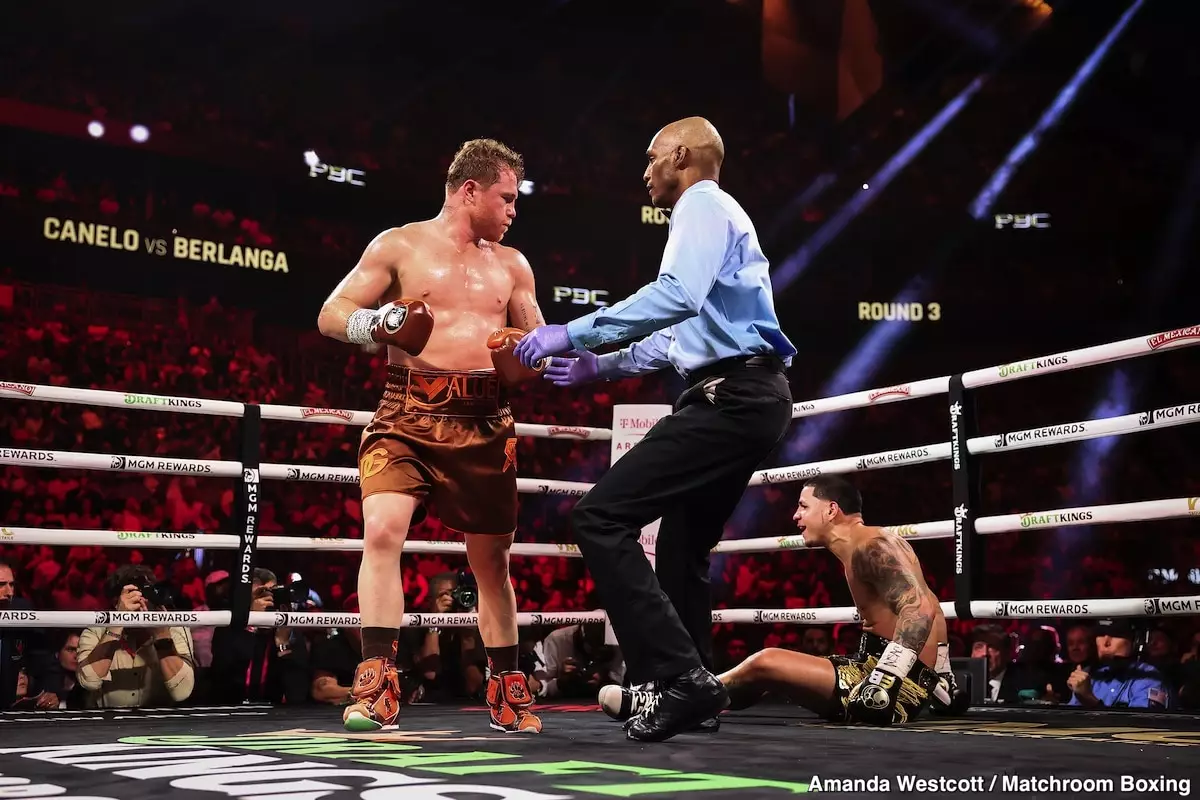Edgar Berlanga’s recent declarations about dominating the super middleweight division and snagging a rematch with Canelo Alvarez reveal more about his confidence than his actual credentials. Despite his loud proclamations, a closer examination exposes a pattern of overestimating his abilities and underestimating the competitive landscape. Berlanga’s record of 23 wins with only one loss, accompanied by an impressive 18 knockouts, paints a picture of a puncher with explosive power. However, beneath the surface lies a fighter whose resume is conspicuously sparse in high-caliber matchups, raising questions about his true readiness for the upper echelon of the division.
His bold claim to “take over” the 168-pound class is a classic case of ambitious bravado—words often used to garner attention and elevate a fighter’s profile. Yet, when scrutinized, his recent record indicates he’s far from being a division dominator. A recent opponent, Jonathan Gonzalez-Ortiz, was so subpar that Berlanga needed only a single round to dispatch him, which, instead of demonstrating growth, highlights the lack of formidable opposition as a stepping stone toward real titles. Such victories, while flashy, don’t establish the foundation necessary for seismic shifts in a division—particularly if one’s goal is to “run it back” with Canelo.
The Reality of the Boxing Hierarchy
Berlanga’s desire for a rematch with Canelo Alvarez, emerging merely months after their one-sided encounter, suggests a misguided sense of entitlement. Canelo’s current status as a dominant figure at 168 pounds is built on consistency, skill, and a series of tough fights against elite opponents. Berlanga’s previous loss to Canelo exposed glaring defensiveness and a lack of adaptability—attributes that cannot be swiftly remedied through bravado alone. Expecting a quick turnaround to face Canelo again overlooks the strategic and managerial reality of boxing: fighters must earn their shot, often through sustained success against elite contenders.
His comments about wanting to “jump the line” reveal a dangerous misunderstanding of how the division functions at the highest level. While ambition is essential, it must be tempered with patience and the humility to accept that progression is earned through merit, not mere proclamations. Many fighters have vocalized similar ambitions, yet very few succeed without a proper foundation of consistent performance. Berlanga’s recent record, including a first-round KO of a limited opponent, should not be mistaken for readiness to challenge the best.
The Challenge of Self-Reflection
What remains striking about Berlanga’s narrative is his apparent inability to critically evaluate his own shortcomings. His confidence is rooted in power rather than technical mastery, evident in his history of struggles with journeymen like Marcelo Coceres and Steve Rolls. These setbacks highlight vulnerabilities—defensive lapses, susceptibility to counters, and a lack of tactical versatility. Rather than acknowledging these flaws and working to improve, Berlanga leans heavily on his knockout power and bravado.
This overconfidence can be dangerous. In boxing, arrogance often precedes downturns, especially when fighters underestimate their opponents or overestimate their scope. Berlanga’s dismissive attitude toward Sheeraz, claiming he will “dust him up,” ignores the reality that boxing often defies predictions. Sheeraz is no punching bag; he is a capable fighter with his own aspirations. Underestimating such opponents can lead to unexpected setbacks that derail even the most ambitious plans.
The Broader Perspective: The Fan’s View
From the standpoint of the boxing community and fans who crave legitimacy over bravado, Berlanga’s bravura statements are viewed with skepticism. His trajectory resembles that of a fighter riding a hype wave, questioning whether he is genuinely on the cusp of greatness or merely riding the coattails of his early knockout prowess. Fans and analysts alike recognize that in order for Berlanga to truly “take over,” he needs to demonstrate consistency, refine his skills, and face more seasoned opponents—not just boast about future opportunities.
The sport rewards patience and perseverance rather than prideful proclamations that often prove hollow. Berlanga’s blaze of confidence could one day serve him well if paired with disciplined development, but right now, it feels like smoke and mirrors—highlighting his unfulfilled potential rather than concrete achievement. If he continues down this path without a realistic appraisal of his current skill set, he risks alienating supporters and undermining his future ambitions.
In essence, Berlanga’s story is a compelling case study of how confidence—when unchecked—can become a double-edged sword. His raw power provides a foundation, but without self-awareness and strategic growth, his lofty goals will remain out of reach, no matter how loudly he proclaims them. True dominance in boxing isn’t achieved through words alone; it demands a combination of grit, skill, humility, and relentless pursuit of mastery.


Leave a Reply